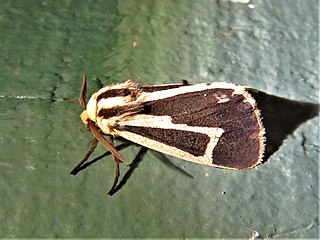Related Research Articles

A grison, also known as a South American wolverine, is any mustelid in the genus Galictis. Native to Central and South America, the genus contains two extant species: the greater grison, which is found widely in South America, through Central America to southern Mexico; and the lesser grison, which is restricted to the southern half of South America.

The greater grison, is a species of mustelid native to Southern Mexico, Central America, and South America.

The lake duck is a small, South American stiff-tailed duck. It is also called the Argentine blue-bill, Argentine blue-billed duck, Argentine lake duck, or Argentine ruddy duck.

The dusky robin is a small passerine bird native to Tasmania. A member of the Australian robin family Petroicidae, it is not related to robins of Europe and North America. It is a brown-plumaged bird of open woodland.

Pteris vittata, commonly known variously as the Chinese brake, Chinese ladder brake, or simply ladder brake, is a fern species in the Pteridoideae subfamily of the Pteridaceae. It is indigenous to Asia, southern Europe, tropical Africa and Australia. The type specimen was collected in China by Pehr Osbeck.

Apantesis vittata, the banded tiger moth, is a moth of the family Erebidae. It was described by Johan Christian Fabricius in 1787. It is found in the United States from Maryland to Florida, west to Kentucky and Louisiana.

Homelix is a genus of longhorn beetles of the subfamily Lamiinae, containing the following species:

The common torrent hawk, is a species of dragonfly in the family Macromiidae. It is found in India, Sri Lanka, and Indonesia. Three subspecies recognized.

Poecilotheria vittata, sometimes called Pederson's ornamental, the ghost ornamental, or magam tiger spider, is an arboreal tarantula. It is endemic to Sri Lanka. In IUCN Red List, the species is cited as a synonym of Indian species Poecilotheria striata, but in other local text books and online publications, it is cited as a separate species. As of February 2016, the species was considered to be native to both India and Sri Lanka by the World Spider Catalog.

Hakea vittata, commonly known as the striped hakea, hooked needlewood, is a shrub of the family Proteaceae. Restricted to an area on the Eyre Peninsula and the Gawler Range in South Australia and small areas in eastern Victoria.
Homelix annuligera is a species of beetle in the family Cerambycidae. It was described by Per Olof Christopher Aurivillius in 1914, originally misspelled as "Homelix annuliger". It is known from Malawi.

Homelix arcuata is a species of beetle in the family Cerambycidae. It was described by Chevrolat in 1855, originally under the genus Pachystola. It is known from Gabon, Cameroon, and Nigeria.

Homelix cribratipennis is a species of beetle in the family Cerambycidae. It was described by James Thomson in 1858. It is known from Tanzania, South Africa, Burundi, Cameroon, Rwanda, the Democratic Republic of the Congo, Gabon, the Ivory Coast, Angola, Malawi, Nigeria, the Republic of the Congo, Sierra Leone, Togo, the Central African Republic, Uganda, Ghana, and Zimbabwe.
Homelix cruciata is a species of beetle in the family Cerambycidae. It was described by Stephan von Breuning in 1937, originally misspelled as "Homelix cruciatus". It is known from Uganda.
Homelix liturata is a species of beetle in the family Cerambycidae. It was described by Quedenfeldt in 1882. It is known from Tanzania, Angola, the Republic of the Congo, the Democratic Republic of the Congo, and possibly from the Ivory Coast.
Homelix morini is a species of beetle in the family Cerambycidae. It was described by Pierre Téocchi in 1999. It is known from Cameroon, the Democratic Republic of the Congo, and the Central African Republic.
Homelix variegata is a species of beetle in the family Cerambycidae. It was described by Karl Jordan in 1894. It is known from the Republic of the Congo, the Democratic Republic of the Congo, and Gabon. It feeds on Coffea canephora.
Homelix albofasciata is a species of beetle in the family Cerambycidae. It was described by James Thomson in 1858, originally spelled as "Homelix albo-fasciata". It is known from Gabon.
Homelix decussata is a species of beetle in the family Cerambycidae. It was described by Chevrolat in 1856, originally under the genus Pachystola. It is known from Nigeria, the Ivory Coast, Cameroon, and the Republic of the Congo. It feeds on Coffea canephora.
Homelix klingi is a species of beetle in the family Cerambycidae. It was described by Kolbe in 1893. It is known from the Central African Republic, Sierra Leone, the Ivory Coast, Kenya, the Democratic Republic of the Congo, Mali, Tanzania, Cameroon, Togo, and Zambia.
References
- ↑ BioLib.cz - Homelix vittata. Retrieved on 8 September 2014.